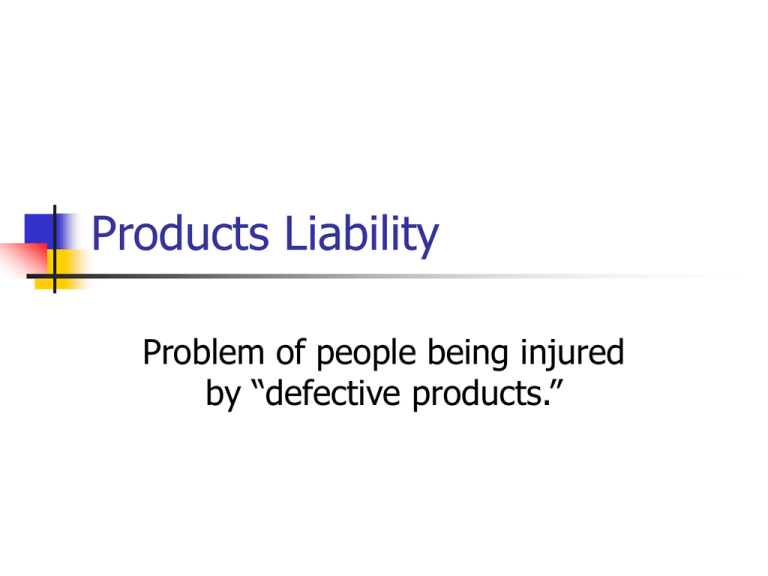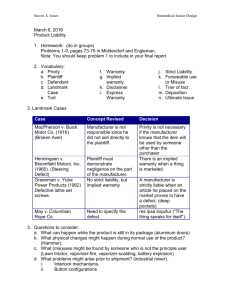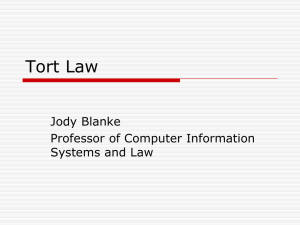Products Liability
advertisement

Products Liability Problem of people being injured by “defective products.” Era of Contract Privity No liability for injury from defective product unless person injured was a party to a contract that was breached; And then, only if contract contained provisions allowing for recovery in the event of injury Rule of “Caveat Emptor” “let the buyer beware” Eventual exceptions for products considered “imminently dangerous.” The Era of Negligence Requirement of privity of contract was first overruled in 1916 in MacPherson v. Buick Motor Co. Plaintiff was injured while driving when the wooden wheel collapsed; Plaintiff sued the manufacturer, Buick Motor Manufacturer argued no duty owed to plaintiff because no contractual relationship MacPherson v. Buick, cont’d Holding: Court overruled the privity of contract rule. Court held: the manufacturer of anything that could foreseeably harm a 3rd party if negligently made was subject to liability. Negligence Standard in Products Liability Duty of Reasonable Care Breach of Duty Causing Injury Resulting in Damages Basic Rule: One who negligently manufacturers a product is liable for any personal injuries proximately caused by his negligence. Plaintiff’s Burden of Proof in Product Negligence Actions Plaintiff has to show: Product was defective when it left the manufacturer’s possession. Rise of Warranty Rules Express Warranty: express representation by a seller or manufacturer that good have certain qualities. Warranties, continued Implied Warranty: “Warranty of Merchantability” implied in every contract for sale of goods. “Warranty of Merchantability” said: goods had to be “fit for the ordinary purposes for which such goods are used.” If not and someone was injured, then seller was liable—regardless of whether negligence could be proven. Impure Food With contaminated food, courts went a step further and Held manufacturer (not just seller) directly responsible to injured buyer No showing of contract required No showing of negligence required Very close to pure strict liability (liability even when there is not proof of negligence) Modern Era of Strict Liability for Defective Products Current Rule: any seller of a product in a defective condition is strictly liable in tort for personal injury or property damage if product is sold in a defective condition. Categories of Products Liability Manufacturing Defects Design Defects Warning Defects Manufacturing Defects Product deviates from the manufacturing design causing the product to be more dangerous than the product as designed. Strict liability: no proof of negligence or contract. Plaintiff has to prove: Product was not manufactured as designed Defect existed at time product left factory Defect resulted in plaintiff’s injury Design Defects All of similar products manufactured are the same and they all have a feature whose design is defective and unreasonably dangerous. Types of Design Defects Structural Defects: Because of D’s choice of materials, product had structural weaknesses which caused it to break or otherwise become dangerous, or Lack of safety features: a safety feature could have been installed with so little expense (compared to cost of product and danger without the feature) that it is defective design not to have safety feature. Proving Design Defect Cases One test--Risk-Benefit Test: Do the risks posed by the design outweigh its benefits? Many courts fall back on a foreseeability test (foreseeability of the risks). More like negligence than strict liability used in manufacturer’s defect cases Reasonable Alternative Design 3rd Restatement: a product has a defective design “when the foreseeable risks of harm posed by the product could have been reduced or avoided by the adoption of a reasonable alternative design by the seller or other distributor…and the omission of the alternative design renders the product not reasonably safe.” Test used with Food Products Consumer Expectations Test: a food product is defective if and only if it contains an ingredient that a reasonable consumer would not expect it to contain. Warning Defects 3rd category of Product Liability Cases Even if a product is properly designed and properly manufactured, the manufacturer must still give a warning if there is a non-obvious risk of injury from using the product. Warning Defects, cont’d First issue: whether risk is so apparent that no warning is necessary. Generally no duty to warn of obvious dangers or of risks that are generally known. Otherwise, “adequate” warning or instruction, typically of “foreseeable” risks is required. Products that are “Unavoidably Unsafe” Products that require both warnings and instructions for use. For example: pharmaceutical products: Warnings of side effects Foreseeable Risks of Use Instructions for Use “Unavoidably Unsafe” Products, cont’d Plaintiff must prove: Lack of adequate warning Causation: that plaintiff would not have used the product or would not have used the product in the way it was used if adequate warning had been given. Problem for Discussion Plaintiff is extremely allergic to peanuts. She eats a peanut butter sandwich and suffers a severe allergic reaction. Is the peanut butter manufacturer liable to her for failing to warn of potential allergic reactions? More on Problem What if plaintiff had eaten a chocolate pastry made with peanut oil? Is the bakery where she bought the pastry liable to her for failure to warn of the presence of peanut oil? Rule for plaintiffs who suffer allergic reactions If the product contains an ingredient to which a substantial number of the population are allergic; The ingredient is one whose danger is not generally known, or if know, is one which the consumer would reasonably not expect to find in the product; And the D knew or should have known of the presence of the ingredient and the danger; Then the case goes to the jury to decide. Defenses Product Misuse Product dangers were obvious Assumption of Risk








